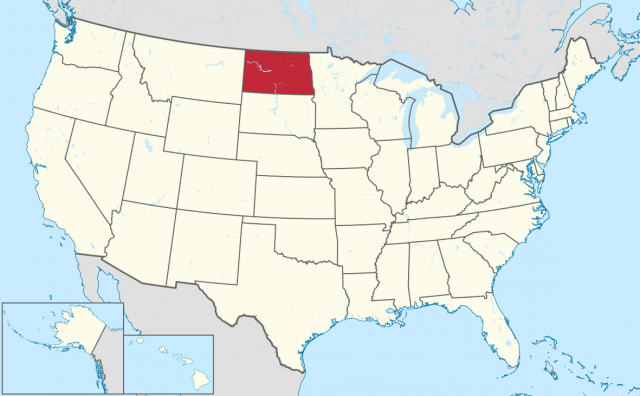The State of North Dakota
AT A GLANCE
Name: Dakota is a Sioux word that means “friends” or “allies.”
Nicknames: Sioux State, Flickertail State, Peace Garden State, Rough Rider State
Capital: Bismarck
Size: 70,704 sq. mi. (13,123 sq km)
Population: 756,927 (2015 est)
Statehood: North Dakota became the 39th state on November 2, 1889.
Electoral votes: 3 (2016)
U.S. representatives: 1 (until 2016)
State tree: American elm
State flower: wild prairie rose
State fish: northern pike
Highest point: White Butte, 3,506 ft. (1,069 m)

THE PLACE
North Dakota is an agricultural state in the Midwest. It is located in the geographic center of North America and borders Canada. The fertile Red River Valley, which lies in the bed of an ancient glacial lake, Lake Agassiz, is located in the eastern part of the state along the Minnesota border.
A large plain, flattened and carved by glaciers 11,500 years ago, is located in the west. Southwestern North Dakota is part of the Great Plains region that extends from Canada to Texas. This hilly highland area is primarily used for grazing cattle.
North Dakota's most prominent rivers are the Missouri and the Red Rivers. The Badlands region of the Little Missouri River is located in southwestern North Dakota. This 190-mile (306-km) -long stretch of land is a sandstone, shale, and clay valley carved out by the movement of water and wind. Buttes, domes, pyramids, and other natural formations rise from the floor of the valley.
The climate of North Dakota is warm, dry, and pleasant in the summer but can be snowy and harsh in the winter. The southeast region of the state receives the most rain and snow, while the western region receives the least. Western North Dakota has large deposits of petroleum and one of the largest beds of lignite coal in the world. North Dakota also has large amounts of sand and clay.
Facts and Firsts
- The geographic center of North America is near Rugby.
- Milk is the official beverage of North Dakota.
- The largest state-owned sheep research center in the United States is at North Dakota State University's research station in Hettinger.
- More sunflowers are grown in North Dakota than in any other state.
THE PAST
North Dakota was once the home of legendary Native American leaders Sitting Bull and Gall. North Dakota was first claimed by France (as part of its Canadian land) and later by Spain. Like much of the Midwest, North Dakota was reclaimed by the French in 1800. The United States bought most of the area from France in 1803 as part of the Louisiana Purchase, then acquired the rest of North Dakota from England in 1818.
At that time, the area was sparsely populated and had very few European settlers. In 1863, the U.S government opened the Dakota Territory to homesteading, and settlers were given free land in the territory if they agreed to farm it. Angry Sioux tribes started to attack settlers' villages.
These attacks did not end until 1881, when Sioux leader Sitting Bull voluntarily surrendered to the U.S. Army.
Several families from the East bought huge farms and became rich on the profits they made from growing wheat. Soon, other settlers came to try to profit from farming.
Transportation in the region improved with the construction of railroads, and more people were able to travel to North Dakota to settle the land. In 1889, North Dakota was admitted into the Union. North Dakota's population expanded rapidly after statehood. Farming continued to grow until the Great Depression of the 1930s, when low food prices hurt North Dakota's agricultural economy. The economy recovered during World War II, however, when North Dakota farms supplied the U.S. military with food.
During the late 1940s, low food prices and advances in machinery left many farm workers jobless. Some people moved to cities to find work, which increased North Dakota's urban population.
THE PRESENT
During the 1980s and 1990s, the government sought to attract new, nonagricultural industries to the state. North Dakota's economy, however, remains more dependent on agriculture than any other state's except South Dakota's. About 90 percent of North Dakota's area is farmland.
The state's farms produce flaxseed, sunflowers, barley, oats, and sugar beets. North Dakota also produces more honey than any other state.
Agricultural jobs are less available as machinery performs more and more of the work. North Dakota has tried hard to attract a larger variety of businesses and industries, but its location—far from east–west trade routes and other densely populated areas—has hurt the effort.
Besides agriculture, North Dakota's economy relies on key industries such as food processing and the manufacture of farm equipment and machinery. Coal, oil, and natural gas production help to balance the state's economy.
Born in North Dakota
- Warren Christopher, statesman
- Angie Dickinson, actress
- Carl Ben Eielson, aviator and explorer
- Dr. Leon O. Jacobson, researcher and educator
- Louis L'Amour, author
- Peggy Lee, singer
- Eric Sevareid, television commentator
- Edward K. Thompson, magazine editor
- Lawrence Welk, band leader